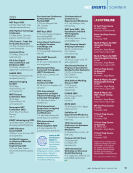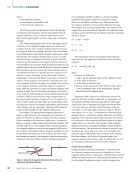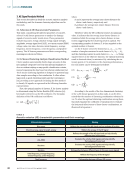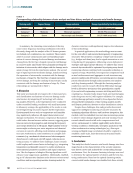levels, and the corresponding damage mechanisms for each
level were analyzed using AE parameter analysis. Finally, the
study established a connection between the clustering analysis
and time history analysis, linking concrete damage severity to
specific damage mechanisms. The main conclusions are as
follows:
1. Based on the Davies-Bouldin (DB) criterion, the optimal
number of clusters for concrete was determined to be three.
This indicates that the AE signals from concrete axial tensile
damage can be divided into three categories using k-means
clustering analysis. This aligns with the time history analysis,
which separates the concrete axial tensile damage process
into three stages, confirming the reliability of the chosen
number of clusters.
2. The k-means clustering analysis for concrete axial tensile
damage resulted in five effective clustering combinations.
Through correlation analysis, the self-similarity among the
AE feature parameters involved in these five combinations
was confirmed, validating the basis for the clustering. Based
on the similarities among the parameters, the information
represented by each combination of parameters for concrete
axial tensile damage can be summarized as follows: ASL–
peak frequency and ASL–center frequency represent the
crack propagation rate, while ring count–ASL, ring count–
peak frequency, and ring count–center frequency represent
fracture strength.
3. Based on the analysis of the cumulative AE hit count time
history curves, this study divides concrete axial tensile
damage into three stages: D1 (0–20% stress level), D2 (20–75%
stress level), and D3 (75–100% stress level). As the stress level
increases, the damage mechanisms corresponding to these
three stages are the initiation of microcracks, the expansion
of microcracks, and the cracking of macroscopic cracks,
respectively.
4. After evaluating the quality of clustering combinations
using the coefficient of variation metric, ring count–center
frequency was selected as the optimal representation of the
concrete axial tensile damage characteristics. Based on the
distribution characteristics of each cluster center, concrete
axial tensile damage was divided into three severity levels.
The underlying AE feature parameter analysis was used to
explain the damage mechanisms corresponding to each
severity level. The first type of signal corresponds to mild
damage, representing the initiation of microcracks the
second type of signal corresponds to moderate damage,
representing the expansion of microcracks and the third
type of signal corresponds to severe damage, representing
the cracking of macroscopic cracks.
5. The three damage levels of concrete axial tensile damage
classified by cluster analysis in this study can provide an
important reference for the maintenance strategy of actual
structures. In the mild damage stage, damage development
can be slowed down by local reinforcement or optimiza-
tion of the use conditions. In the moderate damage stage,
regular monitoring and local repair should be implemented
to prevent microcracks from expanding to more serious
damage. In the severe damage stage, comprehensive repair
or replacement measures should be taken to ensure the
structural safety and service life. Through this approach,
early identification and intervention of damage can be
achieved to optimize the maintenance management strategy
for the structure.
ACKNOWLEDGMENTS
This work was supported by the National Natural Science Foundation of
China (No. 51878245), the National Science Fund for Distinguished Young
Scholars of China (No. 52325803), and the Key Program of the National
Natural Science Foundation of China Regional Innovation and Develop-
ment Joint Fund (No. U22A20229).
REFERENCES
1. Jishu, S., D. Mingyuan, Z. Ji, and W. Jixing. 2011. “Experimental study
on dynamic tensile properties of high-strength concrete.” Building Science
(07): 46–49. https://doi.org/10.13614/j.cnki.11-1962/tu.2011.07.005.
2. Angel, M. G. N., and H. Saboonchi. 2021. “13 – Acoustic emission.” In
Techniques for Corrosion Monitoring, 2nd edition (ed. L. Yang): 305–321.
Woodhead Publishing. https://doi.org/10.1016/B978-0-08-103003-
5.00013-8.
3. Wang, Y., S. Chen, Z. Xu, S. Liu, and H. Hu. 2018. “Damage processes of
polypropylene fiber reinforced mortar in different fiber content revealed
by acoustic emission behavior.” Journal of Wuhan University of Tech-
nology—Materials Science Edition 33 (1): 155–63. https://doi.org/10.1007/
s11595-018-1800-5.
4. Aggelis, D. G., A. C. Mpalaskas, T. E. Matikas, and D. Van Hemelrijck.
2013. “Acoustic emission signatures of damage modes in structural mate-
rials.” Proc. SPIE 8694: Nondestructive Characterization for Composite
Materials, Aerospace Engineering, Civil Infrastructure, and Homeland
Security. https://doi.org/10.1117/12.2008942.
5. Jiao, J., and P. Wang. 2025. “Design of Eddy Current Non-destructive
Testing System for Inner Surface of Oil and Gas Pipelines.” J Machine
Building &Automation 54 (01): 16–19. https://doi.org/10.19344/j.cnki.
issn1671-5276.2025.01.004 [in Chinese].
6. Li, H., and L. Gu. 2025. “Research on Comparative Analysis and Selec-
tion Strategies for Non-Destructive Testing Methods of Pressure Vessel
Inner Surfaces.” J New Technologies and New Products of China (03): 62–64.
https://doi.org/10.13612/j.cnki.cntp.2025.03.025 [in Chinese].
7. Yiwen, Y., X. Shan, W. Rui, and D. Xianghui. 2022. A new species of the
genus Pterocarpus (Hymenoptera, Braconidae, Pterocarpinae) from China.
“Non-destructive testing of frost durability of concrete box girders in
alpine region.” Journal of Xi’an Technological University (042–001). https://
doi.org/10.16185/j.jxatu.edu.cn.2022.01.204 [in Chinese].
8. Yan, W., W. Yao, Y. Jinxin, L. Guijuan, and X. Zhengzheng. 2012.
“Summary of research on acoustic emission characteristics of concrete
under axial tension damage.” Water Resources and Hydropower Engi-
neering (12): 92–95, 99. https://doi.org/10.13928/j.cnki.wrahe.2012.12.003
[in Chinese].
9. Liu, K., T. Wulan, Y. Yao, M. Bian, and Y. Bao. 2024. “Assessment of
damage evolution of concrete beams strengthened with BFRP sheets with
acoustic emission and unsupervised machine learning.” Engineering Struc-
tures 300:117228. https://doi.org/10.1016/j.engstruct.2023.117228.
10. Zhang, D., S. Zhang, S. M. Chayan, Y. Fan, S. P. Shah, and J. Zheng.
2025. “Time-frequency characterization of acoustic emission signals
from bending damage of corroded reinforced concrete beams in
high-temperature saline environment.” Case Studies in Construction
Materials 22: e04237. https://doi.org/10.1016/j.cscm.2025.e04237.
M AY 2 0 2 5 • M AT E R I A L S E V A L U AT I O N 51
level were analyzed using AE parameter analysis. Finally, the
study established a connection between the clustering analysis
and time history analysis, linking concrete damage severity to
specific damage mechanisms. The main conclusions are as
follows:
1. Based on the Davies-Bouldin (DB) criterion, the optimal
number of clusters for concrete was determined to be three.
This indicates that the AE signals from concrete axial tensile
damage can be divided into three categories using k-means
clustering analysis. This aligns with the time history analysis,
which separates the concrete axial tensile damage process
into three stages, confirming the reliability of the chosen
number of clusters.
2. The k-means clustering analysis for concrete axial tensile
damage resulted in five effective clustering combinations.
Through correlation analysis, the self-similarity among the
AE feature parameters involved in these five combinations
was confirmed, validating the basis for the clustering. Based
on the similarities among the parameters, the information
represented by each combination of parameters for concrete
axial tensile damage can be summarized as follows: ASL–
peak frequency and ASL–center frequency represent the
crack propagation rate, while ring count–ASL, ring count–
peak frequency, and ring count–center frequency represent
fracture strength.
3. Based on the analysis of the cumulative AE hit count time
history curves, this study divides concrete axial tensile
damage into three stages: D1 (0–20% stress level), D2 (20–75%
stress level), and D3 (75–100% stress level). As the stress level
increases, the damage mechanisms corresponding to these
three stages are the initiation of microcracks, the expansion
of microcracks, and the cracking of macroscopic cracks,
respectively.
4. After evaluating the quality of clustering combinations
using the coefficient of variation metric, ring count–center
frequency was selected as the optimal representation of the
concrete axial tensile damage characteristics. Based on the
distribution characteristics of each cluster center, concrete
axial tensile damage was divided into three severity levels.
The underlying AE feature parameter analysis was used to
explain the damage mechanisms corresponding to each
severity level. The first type of signal corresponds to mild
damage, representing the initiation of microcracks the
second type of signal corresponds to moderate damage,
representing the expansion of microcracks and the third
type of signal corresponds to severe damage, representing
the cracking of macroscopic cracks.
5. The three damage levels of concrete axial tensile damage
classified by cluster analysis in this study can provide an
important reference for the maintenance strategy of actual
structures. In the mild damage stage, damage development
can be slowed down by local reinforcement or optimiza-
tion of the use conditions. In the moderate damage stage,
regular monitoring and local repair should be implemented
to prevent microcracks from expanding to more serious
damage. In the severe damage stage, comprehensive repair
or replacement measures should be taken to ensure the
structural safety and service life. Through this approach,
early identification and intervention of damage can be
achieved to optimize the maintenance management strategy
for the structure.
ACKNOWLEDGMENTS
This work was supported by the National Natural Science Foundation of
China (No. 51878245), the National Science Fund for Distinguished Young
Scholars of China (No. 52325803), and the Key Program of the National
Natural Science Foundation of China Regional Innovation and Develop-
ment Joint Fund (No. U22A20229).
REFERENCES
1. Jishu, S., D. Mingyuan, Z. Ji, and W. Jixing. 2011. “Experimental study
on dynamic tensile properties of high-strength concrete.” Building Science
(07): 46–49. https://doi.org/10.13614/j.cnki.11-1962/tu.2011.07.005.
2. Angel, M. G. N., and H. Saboonchi. 2021. “13 – Acoustic emission.” In
Techniques for Corrosion Monitoring, 2nd edition (ed. L. Yang): 305–321.
Woodhead Publishing. https://doi.org/10.1016/B978-0-08-103003-
5.00013-8.
3. Wang, Y., S. Chen, Z. Xu, S. Liu, and H. Hu. 2018. “Damage processes of
polypropylene fiber reinforced mortar in different fiber content revealed
by acoustic emission behavior.” Journal of Wuhan University of Tech-
nology—Materials Science Edition 33 (1): 155–63. https://doi.org/10.1007/
s11595-018-1800-5.
4. Aggelis, D. G., A. C. Mpalaskas, T. E. Matikas, and D. Van Hemelrijck.
2013. “Acoustic emission signatures of damage modes in structural mate-
rials.” Proc. SPIE 8694: Nondestructive Characterization for Composite
Materials, Aerospace Engineering, Civil Infrastructure, and Homeland
Security. https://doi.org/10.1117/12.2008942.
5. Jiao, J., and P. Wang. 2025. “Design of Eddy Current Non-destructive
Testing System for Inner Surface of Oil and Gas Pipelines.” J Machine
Building &Automation 54 (01): 16–19. https://doi.org/10.19344/j.cnki.
issn1671-5276.2025.01.004 [in Chinese].
6. Li, H., and L. Gu. 2025. “Research on Comparative Analysis and Selec-
tion Strategies for Non-Destructive Testing Methods of Pressure Vessel
Inner Surfaces.” J New Technologies and New Products of China (03): 62–64.
https://doi.org/10.13612/j.cnki.cntp.2025.03.025 [in Chinese].
7. Yiwen, Y., X. Shan, W. Rui, and D. Xianghui. 2022. A new species of the
genus Pterocarpus (Hymenoptera, Braconidae, Pterocarpinae) from China.
“Non-destructive testing of frost durability of concrete box girders in
alpine region.” Journal of Xi’an Technological University (042–001). https://
doi.org/10.16185/j.jxatu.edu.cn.2022.01.204 [in Chinese].
8. Yan, W., W. Yao, Y. Jinxin, L. Guijuan, and X. Zhengzheng. 2012.
“Summary of research on acoustic emission characteristics of concrete
under axial tension damage.” Water Resources and Hydropower Engi-
neering (12): 92–95, 99. https://doi.org/10.13928/j.cnki.wrahe.2012.12.003
[in Chinese].
9. Liu, K., T. Wulan, Y. Yao, M. Bian, and Y. Bao. 2024. “Assessment of
damage evolution of concrete beams strengthened with BFRP sheets with
acoustic emission and unsupervised machine learning.” Engineering Struc-
tures 300:117228. https://doi.org/10.1016/j.engstruct.2023.117228.
10. Zhang, D., S. Zhang, S. M. Chayan, Y. Fan, S. P. Shah, and J. Zheng.
2025. “Time-frequency characterization of acoustic emission signals
from bending damage of corroded reinforced concrete beams in
high-temperature saline environment.” Case Studies in Construction
Materials 22: e04237. https://doi.org/10.1016/j.cscm.2025.e04237.
M AY 2 0 2 5 • M AT E R I A L S E V A L U AT I O N 51













































































